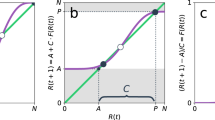Abstract
In Regulatory Networks, Population Level Effects and Threshold Models of Collective Action, Mark Fenwick explores the question of whether we might push the network metaphor further and examine whether regulatory networks exhibit “network dynamics”. The study of networks dynamics is an inter-disciplinary field that has emerged at the intersection between sociology, social psychology and economics. The chapter suggests that one form of network dynamic, namely a threshold model of collective action, can be helpful in providing a new conceptual vocabulary for describing various features of regulatory networks. In particular, it allows us to move away from accounts that regard networks as expressing the collective normative preferences of participants and ideas of contractual consent.
Access this chapter
Tax calculation will be finalised at checkout
Purchases are for personal use only
Similar content being viewed by others
Notes
- 1.
Weber (1968), p. 23.
- 2.
By way of a preliminary caveat, it is worth noting that TGRNs often entail the participation of quasi-public and non-state actors, such as NGOs, trade associations etc., and, as such, are not the exclusive preserve of public authorities, although this is not an issue I shall explore in here. Moreover, such networks often blur the public–private structure.
- 3.
- 4.
For an excellent introduction to this field, see Easley and Kleinberg (2010).
- 5.
See Raustiala (2002).
- 6.
This chapter will draw on the work of Marc Granovetter, in particular Granovetter (1978).
- 7.
See Katz and Shapiro (1985).
- 8.
Moreover, since in the context of a lot of contemporary regulation the objects of regulation—companies or individuals—“voluntarily” submit to that regulation their decisions to “join” a network might also be usefully understood via threshold models.
- 9.
Keohane and Nye (1974), p. 39.
- 10.
See Slaughter (1997).
- 11.
Slaughter and Zaring (2006), p. 1.
- 12.
See Verdier (2009).
- 13.
Katz and Shapiro (1985), p. 43.
- 14.
- 15.
Matza (1964).
- 16.
For example, “[s]haring values makes agreement on common goals easier, and ‘confidence’ in competence and integrity makes commitment to mutual involvement in such goals easier … All these considerations focus mutual trust in the conception or ‘feeling’ of the solidarity of collective groups”. Parsons (1978), pp. 46–47.
- 17.
See e.g. Sztompka (1999).
- 18.
The following discussion draws, in particular, on the work of Granovetter (1978).
- 19.
In the following, I am using “standard” in a broad sense to refer to any routinized rules, policies, or practices.
References
Braithwaite J, Drahos P (2000) Global business regulation. Cambridge University Press, Cambridge
Cross M (2012) Rethinking epistemic communities twenty years later. Rev Int Stud 5:1–30
Easley D, Kleinberg J (2010) Networks, crowds and markets: reasoning about a highly connected world. Cambridge University Press, Cambridge
Granovetter M (1978) Threshold models of collective action. Am J Sociol 83:1420–1443
Haas P (1992) Epistemic communities and international policy coordination. Int Organ 46:1–35
Katz ML, Shapiro C (1985) Network externalities, competition and compatibility. Am Econ Rev 75:424–440
Keohane R, Nye JS (1974) Trans governmental relations and international organizations. World Polit 27:39–61
Matza D (1964) Delinquency and drift. Transaction Press, New York
Parsons T (1978) Action theory and the human condition. Free Press, New York
Raustiala K (2002) The architecture of international cooperation: trans-governmental networks and the future of international law. V J Int Law 43:1–92
Slaughter AM (1997) The real new world order. Foreign Aff 76:183–187
Slaughter AM (2004) A new world order. Government networks and the disaggregated state. Princeton University Press, Princeton
Slaughter AM, Zaring D (2006) Networking goes international. Annu Rev Law Soc Sci 2:211–218
Sztompka P (1999) Trust: a sociological theory. Cambridge University Press, Cambridge
Verdier PH (2009) Transnational regulatory networks and their limits. Yale J Int Law 34:113–172
Weber M (1968 [1921]) Economy and society: an outline of interpretive sociology. Bedminster, London
Author information
Authors and Affiliations
Corresponding author
Editor information
Editors and Affiliations
Rights and permissions
Copyright information
© 2014 Springer-Verlag Berlin Heidelberg
About this chapter
Cite this chapter
Fenwick, M. (2014). Regulatory Networks, Population Level Effects and Threshold Models of Collective Action. In: Fenwick, M., Van Uytsel, S., Wrbka, S. (eds) Networked Governance, Transnational Business and the Law. Springer, Berlin, Heidelberg. https://doi.org/10.1007/978-3-642-41212-7_5
Download citation
DOI: https://doi.org/10.1007/978-3-642-41212-7_5
Published:
Publisher Name: Springer, Berlin, Heidelberg
Print ISBN: 978-3-642-41211-0
Online ISBN: 978-3-642-41212-7
eBook Packages: Humanities, Social Sciences and LawLaw and Criminology (R0)




